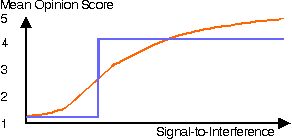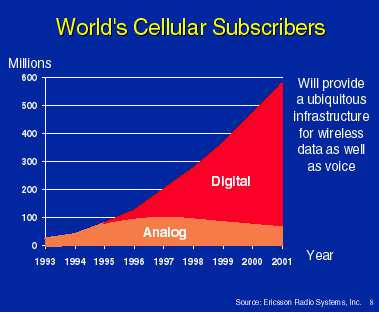
Advantages of Digital Transmission
Many analog systems are now being replaced by digital systems.
we see this trend in
cellular telephony, cordless telephones, broadcasting and many other services.
- Higher capacity due to
- speech coding (or audio and video coding in case of digital broadcasting)
- smaller protection ratios, denser reuse, particularly the
possibility to use error correction significantly improves performance and/or efficiency.
- Security
- User privacy
- Protected against unauthorized use
- In case of digital broadcasting: Conditional access
- Additional services
Examples of Digital Systems
Audio Quality

Figure: Sound Quality (in MOS) versus signal-to-interference ratio. Indigo: digital; orange: analog
Digital transmission can guarantee that the audio quality is acceptable or good for signals above a certain threshold. Above the threshold, the quality mainly depends on the speech coding algorithm. The GSM speech coding works at 9.6 kbit/s.
With analogue transmission, increasing the C/I improves performance.
This is why some users, particularly those that mostly make their calls when stationary close to a base station, prefer the analog sound quality
over a tightly designed digital system with heavy speech compression.







